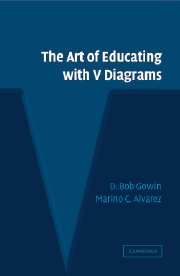Book contents
- Frontmatter
- Contents
- Foreword
- Preface
- Acknowledgment
- PART ONE FOUR COMMONPLACES OF EDUCATING PLUS ONE
- PART TWO THE V DIAGRAM
- PART THREE ANALYZING, EVALUATING, AND CONDUCTING RESEARCH
- PART FOUR REASONING WITH TECHNOLOGY
- Part 4 Summary
- Epilogue
- Appendices
- Appendix I V Diagram Scoring Protocol
- Appendix II Research Phases and Questions
- Appendix III Scoring Criteria for Concept Maps
- Bibliography
- Name Index
- Subject Index
Appendix III - Scoring Criteria for Concept Maps
Published online by Cambridge University Press: 19 November 2009
- Frontmatter
- Contents
- Foreword
- Preface
- Acknowledgment
- PART ONE FOUR COMMONPLACES OF EDUCATING PLUS ONE
- PART TWO THE V DIAGRAM
- PART THREE ANALYZING, EVALUATING, AND CONDUCTING RESEARCH
- PART FOUR REASONING WITH TECHNOLOGY
- Part 4 Summary
- Epilogue
- Appendices
- Appendix I V Diagram Scoring Protocol
- Appendix II Research Phases and Questions
- Appendix III Scoring Criteria for Concept Maps
- Bibliography
- Name Index
- Subject Index
Summary
Hierarchy. The map shows hierarchy by displaying different levels of space. It moves from most inclusive concept, to less inclusive concepts, to least inclusive concepts: superordinate, coordinate, and subordinate. Five points are awarded for each level of space. Examples and nonexamples do not constitute a level.
Relationships. Each concept is linked by a line which signifies a proposition (a meaning relationship) between two concepts. In order to receive points the concept should be connected to the other and be meaningful. If the relationship is valid and the word or a word phrase is labeled on the proposition (line) 3 points are awarded. If the relationship is valid, but is not labeled, 1 point is awarded. Crosslinks, examples and nonexamples are not counted as relationships.
Branching. This occurs when a coordinate or subordinate concept has links to several specific concepts. Within each hierarchical level, points are awarded for each coordinate, subordinate, and specific concept listed within a grouping: Level 1 = 5 points; Level 2 = 4 points; Level 3 = 3 points; Level 4 = 2 points; Level 5 and beyond = 1 point. Examples and nonexamples are not counted as branches.
Cross Links. Ten points are awarded when one meaningful segment of the map is connected to another segment of the map (shown by a broken line in the scoring model). This cross link connection needs to be both valid and significant. Cross links indicate thought, creative ability, and unique awareness.
- Type
- Chapter
- Information
- The Art of Educating with V Diagrams , pp. 215 - 220Publisher: Cambridge University PressPrint publication year: 2005



